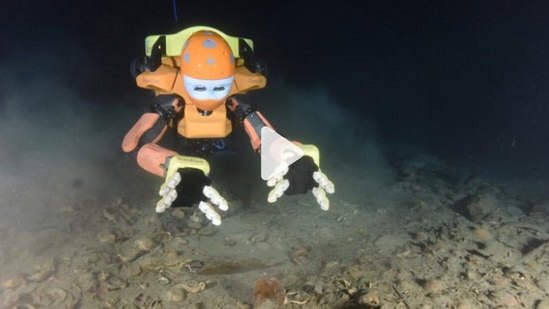Stanford University's ‘OceanOneK’: All you need to know about the robot
The machine has been developed to locate shipwrecks and sunken planes deep inside the ocean where human divers cannot reach.
Scientists at Stanford University in California have created a robot – named ‘OceanOneK’ by them – that can dive deep into the ocean to locate shipwrecks and sunken planes. The robot, which has a predecessor, ‘OceanOne’ (2016), was built out of a desire to study coral reefs within the Red Sea, and beyond the reach of divers, reported CNN.

Here's all you need to know about OceanOneK:
(1.) Shape and structure: Essentially a humanoid, the OceanOneK resembles a human diver from the front; it has arms, hands, and eyes with 3D vision. On the back, it is equipped with computers and eight multidirectional thrusters that help it reach the sites of sunken ships.
The robot has a height of 5 feet (1.5 metres) and is built to handle objects without breaking them.
(2.) How does it work: Though the machine is controlled by an operator, it is also fitted with sensors and algorithms so that it can function automatically and avoid collisions.
Also, as OceanOneK has a touch-based feedback system, the person operating it feels as if he/she is underwater as well.
(3.) Reach and modifications: While OceanOne has a maximum reach of 656 feet (200 metres), its successor was created with a new goal: 1 km or 1,000 metres (0.62 miles), and hence the name ‘OceanOneK’.
To achieve this, the team changed the robot's body with a special foam (that includes glass microspheres) to increase its buoyancy and combat the pressure of 1,000 metres. They also upgraded the machine's arms, gave it two new types of hands, and increase its arm and head motion.
(4.) Challenges: In February, during a deep dive, when scientists stopped for a thruster check, they discovered that the robot couldn't ascend. This happened because flotations on the communication and power lines collapsed, resulting in the line piling on top of the robot.
(5.) Missions accomplished: The machine has, so far, explored a sunken Beechcraft Baron F-GDPV plane, Italian steamship Le Francesco Crispi, a second century Roman ship off Corsica (1,095 feet/334 metres), a World War II P-38 Lightning aircraft and a submarine called Le Protée (406 feet/124 metres).






